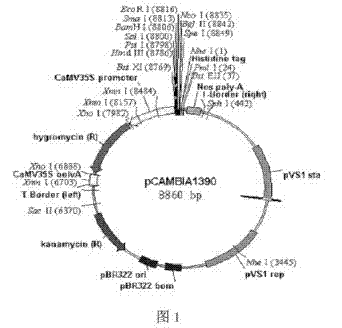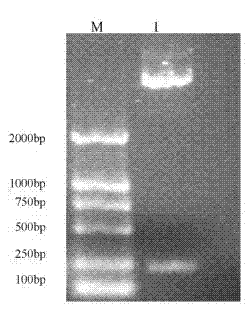Method for producing cecropins by using alfalfa as bioreactor
A production method and a peptide cecropin technology are applied in the field of producing the antimicrobial peptide Cecropin B (Cecropin B, CB), and can solve the problems of high cost, inability to obtain expression products, host microorganism suicide, and the like
- Summary
- Abstract
- Description
- Claims
- Application Information
AI Technical Summary
Problems solved by technology
Method used
Image
Examples
Embodiment 1
[0037] The construction of embodiment 1 plant binary expression vector pCAMBIA1390R
[0038] The pCAMBIA1390R plasmid was constructed in this laboratory, with the plant expression vector pCAMBIA1390 as the basic skeleton, and endonuclease xho I and Bgl I was digested with enzymes, and the large fragment of the vector was recovered; it was connected with the cauliflower mosaic virus CaMV35S promoter synthesized in vitro, and a plant expression vector containing the CaMV35S promoter was obtained, which was named pCAMBIA1390R. See pCAMBIA1390R plasmid map figure 1 .
Embodiment 2
[0039] Example 2 Construction and Transformation of Plant Expression Vector pCAMBIA1390R-CB
[0040] 1、 According to the CecropinB base sequence registered on GenBank, the Primer Premier 5.0 software was used to reshape the CB base sequence according to plant-preferred codons, and a single-gene CB was artificially synthesized. The base sequence is shown in the sequence table SEQ ID NO.1. Design primers:
[0041] P1: CGG GGTACC ATGAACTTCGCGAAGATCCT
[0042] P2: AAAACTGCAGTCACTTCCCTATTGCTTTAG
[0043] Artificially synthesized single-gene CB templates were amplified by PCR. PCR reaction conditions: Pre-denaturation at 94.0°C for 5 minutes, denaturation at 94.0°C for 35s, annealing at 65.0°C for 35s, extension at 72.0°C for 35s, 30 cycles, extension at 72.0°C for 2 minutes, and storage at 4°C until the end. After 1% agarose gel electrophoresis detected that the bands were correct and there were no non-specific bands, the PCR cleaning and recovery kit was used to purify a...
Embodiment 3
[0070] Example 3 Plant expression vector pCAMBIA1390R-CB 2 Construct
[0071] 1. Design primers:
[0072] P3: CGG GGTACC AGATCTATGAAC TTCGCGAAGATCCT
[0073] P4: AAAA CTGCAG GGATCCCCTTCCCTATTGCTTTAGCAGAC
[0074] Using its base sequence as shown in the sequence table SEQ ID NO.1, the artificially synthesized single gene CB is used as a template, and the reaction system is according to Table 7;
[0075] Table 7 The first round of PCR reaction system
[0076] Component Volume dNTP Mix 4μl 10× Buffer 5μl Primer P3 1μl Primer P4 1μl Pyrobest DNA polymerase 0.25μl h 2 o 38.75μl Total volume 50μl
[0077] PCR reaction conditions: Pre-denaturation at 94.0°C for 5 minutes, denaturation at 94.0°C for 35s, annealing at 65.0°C for 35s, extension at 72.0°C for 35s, 30 cycles, extension at 72.0°C for 2 minutes, and storage at 4°C until the end. After 1% agarose gel electrophoresis detected that the bands were corr...
PUM
 Login to View More
Login to View More Abstract
Description
Claims
Application Information
 Login to View More
Login to View More - R&D
- Intellectual Property
- Life Sciences
- Materials
- Tech Scout
- Unparalleled Data Quality
- Higher Quality Content
- 60% Fewer Hallucinations
Browse by: Latest US Patents, China's latest patents, Technical Efficacy Thesaurus, Application Domain, Technology Topic, Popular Technical Reports.
© 2025 PatSnap. All rights reserved.Legal|Privacy policy|Modern Slavery Act Transparency Statement|Sitemap|About US| Contact US: help@patsnap.com



